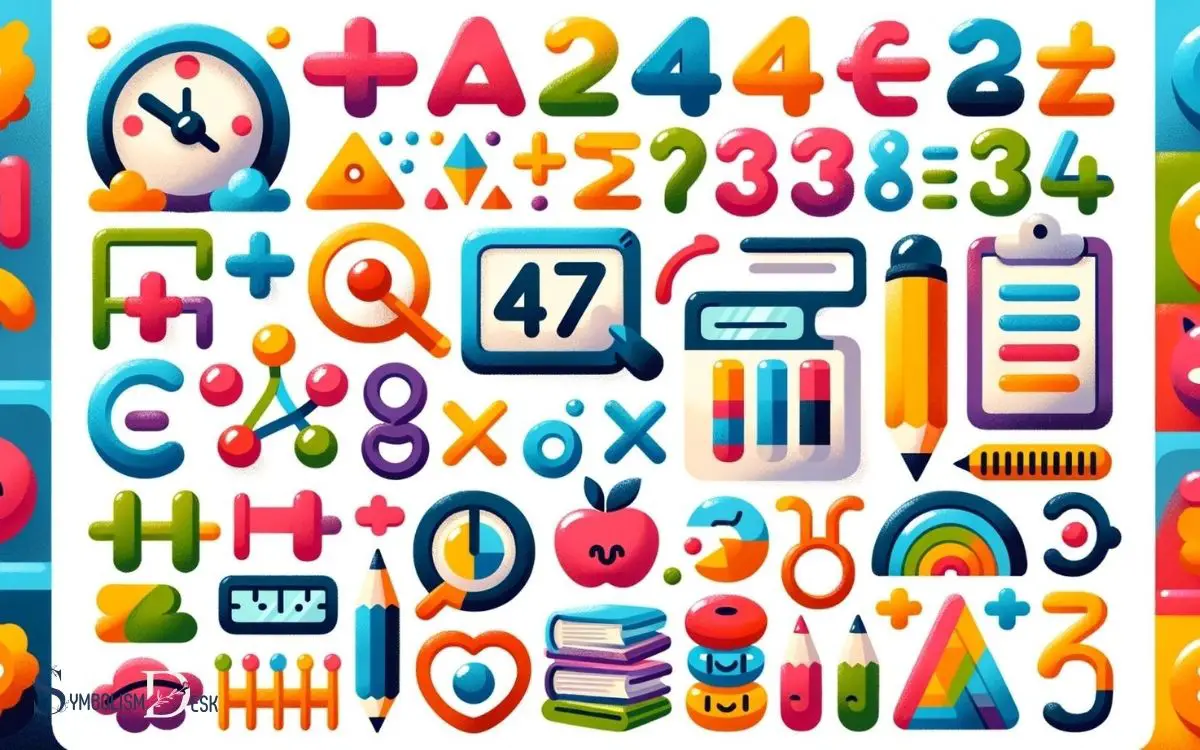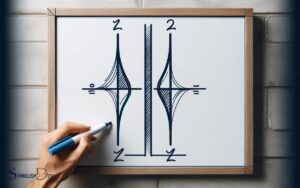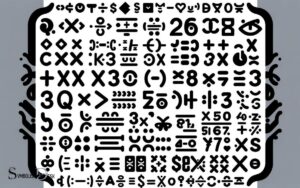Math Symbols for Elementary Students: Operations!
Math symbols are essential tools for elementary students to learn and understand in order to effectively navigate the basics of mathematics.
These symbols are the language of math, representing numbers, operations, and relations that are fundamental to arithmetic, geometry, algebra, and more. Knowing these symbols is the first step towards building mathematical literacy and competency.
Math symbols for elementary students include a variety of characters, each with a specific meaning.
Here’s a brief overview:
For example, in the equation 3 + 4 = 7, the symbols “+” and “=” are used to indicate that three added to four equals seven.
Mastering math symbols empowers students to excel in problem-solving and mathematical communication.

Key Takeaway
Comprehensive Table of Math Symbols for Elementary Students
| Symbol | Name | Example | Description |
|---|---|---|---|
| + | Plus | 2 + 3 | Indicates addition |
| – | Minus | 5 – 2 | Indicates subtraction |
| × or * | Times | 4 × 3 | Indicates multiplication |
| ÷ or / | Divided by | 8 ÷ 4 | Indicates division |
| = | Equals | 3 + 4 = 7 | Represents equality |
| ≠ | Not equal | 5 ≠ 4 | Represents inequality |
| < | Less than | 3 < 5 | Indicates a number is smaller than another |
| > | Greater than | 6 > 2 | Indicates a number is larger than another |
| ≤ | Less than or equal | 4 ≤ 5 | Number is smaller or equal to another |
| ≥ | Greater than or equal | 6 ≥ 6 | Number is larger or equal to another |
| Parallel | |||
| ⊥ | Perpendicular | EF ⊥ GH | Indicates two lines are perpendicular |
| ̂ | Angle | ∠ABC | Represents an angle |
| / | Fraction bar | ½ | Used to represent fractions |
| . | Decimal point | 3.14 | Used to represent decimals |
Understanding Basic Arithmetic Symbols
Understanding basic arithmetic symbols is essential for elementary students as they begin to develop their mathematical skills. These symbols serve as the building blocks for more complex mathematical concepts. Understanding basic arithmetic symbols is not only important for solving simple math problems, but also for grasping more advanced mathematical functions. From addition and subtraction to multiplication and division, these symbols lay the foundation for comprehending more intricate mathematical concepts. As students become more comfortable with basic arithmetic, they can then progress to understanding mathematical functions such as exponents, square roots, and algebraic equations.
The plus sign (+) indicates addition, the minus sign (-) represents subtraction, the multiplication sign (×) denotes multiplication, and the division sign (÷) signifies division.
Mastery of these symbols is fundamental for students to solve simple equations and understand fundamental mathematical operations.
For instance, the plus and minus signs are used in basic number sentences, while the multiplication and division signs are crucial for introducing the concept of equal groups and sharing equally.
Proficiency in using these symbols lays a strong foundation for students to progress to more advanced mathematical concepts, such as algebra and geometry, which rely on a solid understanding of basic arithmetic symbols.
Exploring Common Geometric Symbols
Geometric symbols play a crucial role in elementary mathematics education, providing visual representations of fundamental geometric concepts. One common geometric symbol is the triangle, often denoted as △.
This symbol represents a polygon with three sides. Another important symbol is the circle, represented by O, which signifies a set of points in a plane that are equidistant from a given point, known as the center.
Rectangles and squares are often represented by ▭ and □, respectively, to illustrate four-sided figures with opposite sides of equal length and four right angles.
Moreover, the symbol ∠ is used to denote an angle, which is formed by two rays sharing a common endpoint.
Understanding these geometric symbols is essential for comprehending basic geometric principles, laying a strong foundation for future mathematical learning.
Introducing Fundamental Algebraic Symbols
Fundamentals of algebraic symbols are essential for building a strong foundation in elementary mathematics education. Algebraic symbols represent quantities and relationships, laying the groundwork for solving equations and understanding patterns.
The most fundamental algebraic symbols include variables (usually represented by letters like x or y) and constants (specific numbers).
Variables can take on different values, while constants remain fixed. Elementary students encounter these symbols when learning basic equations and expressions.
For example, in the equation 3x + 5 = 11, ‘x’ is the variable representing an unknown quantity, and 3 and 5 are constants.
Introducing these fundamental algebraic symbols at an early stage helps students grasp the concept of unknowns and the manipulation of quantities, setting the stage for more advanced algebraic concepts in later education.
Deciphering Essential Fraction Symbols
Encountering fundamental algebraic symbols sets the stage for elementary students to decipher essential fraction symbols, as they continue to explore mathematical concepts and their representations.
Fractions are a crucial part of elementary math, and understanding their symbols is fundamental for further learning.
Below is a table that outlines some essential fraction symbols and their meanings:
| Symbol | Meaning |
|---|---|
| 1/2 | Half |
| 1/4 | Quarter |
| 3/4 | Three-quarters |
| 2/3 | Two-thirds |
| 3/5 | Three-fifths |
| 4/5 | Four-fifths |
Understanding these symbols is key to comprehending fractions and their applications in real-world problem-solving and everyday life.
Unveiling Key Measurement Symbols
As elementary students progress in their mathematical education, it is essential to introduce them to key measurement symbols, which play a crucial role in understanding and applying various mathematical concepts.
Some of the fundamental measurement symbols include “cm” for centimeters, “m” for meters, “kg” for kilograms, “g” for grams, “L” for liters, “mL” for milliliters, and “°” for degrees.
These symbols are used to represent units of length, weight, volume, and angle measurements. Understanding these symbols is vital for students as they begin to solve problems involving measurements, conversions, and real-world applications.
By familiarizing themselves with these measurement symbols, elementary students can develop a solid foundation for more advanced mathematical concepts and practical skills essential in everyday life.
Conclusion
Mastering the language of math symbols is crucial for elementary students to build a strong foundation in mathematics.
From basic arithmetic symbols to fundamental algebraic symbols, these mathematical tools serve as a universal language for problem-solving and critical thinking.
Just as a compass guides a traveler on their journey, these symbols serve as guiding stars for students as they navigate the world of mathematics.






